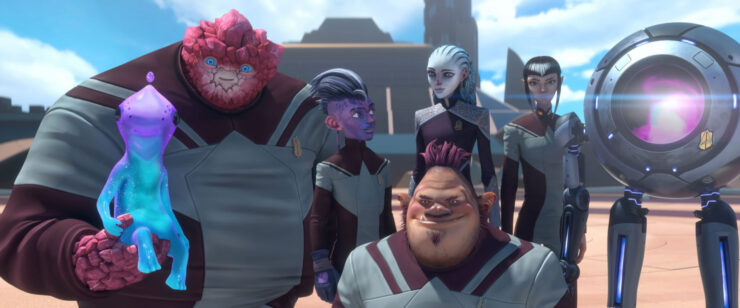Back in October of 2021, I declared Star Trek: Prodigy to be the best of the new Trek series. Since I made that declaration, the competition has gotten stiffer, as Discovery aired its best season, Lower Decks aired its two best seasons, and Strange New Worlds debuted and gave us two fabulous seasons as well. And, um, Picard seasons two and three also happened.
Having just finished watching all twenty episodes of Prodigy’s sophomore season, I stand by what I said three years ago. This show is fantastic.
[Spoilers follow for season 2 of Star Trek: Prodigy]
The second season picks up nicely from the first. What’s more, the main characters are all in Starfleet now, as warrant officers and Academy candidates, which means the show can embrace the greater Trek universe more aggressively.
In particular, the show feels very much like a Voyager spinoff, as evidenced not only by the presence of both Admiral Janeway and hologram Janeway (yes, she’s back even though the Protostar was destroyed—more on that in a bit), but also with the addition of the Roberts Beltran and Picardo to the opening credits as Chakotay and the EMH, respectively. Plus, a big chunk of the action of this season takes place on a newly commissioned Voyager. (The original having been established in both LD’s “Twovix” and Picard’s “The Bounty” as being a literal museum piece now.)
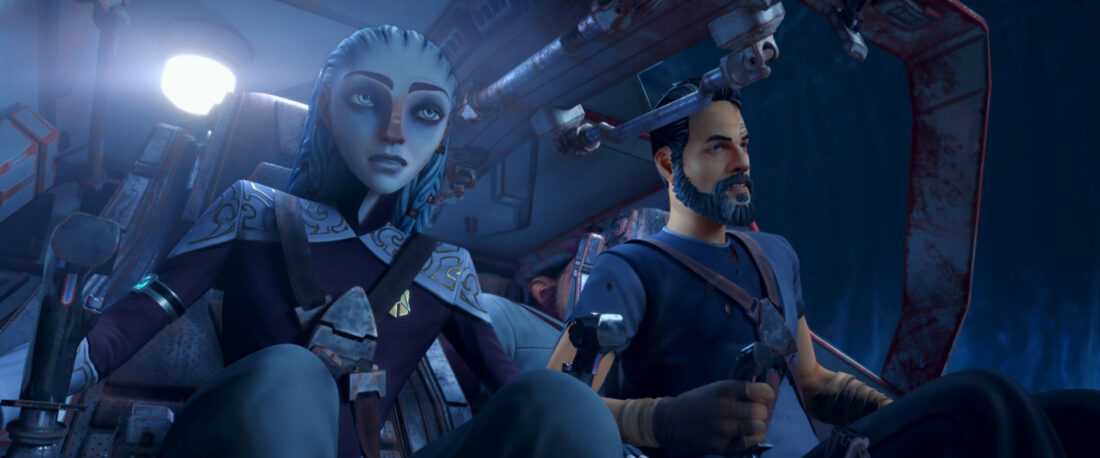
And the driving force of the beginning of the season is to rescue Chakotay. The wormhole created by the Protostar’s destruction at the end of last season is still there, and they got a distress call from Chakotay 52 years in the future on Solum. Voyager is undertaking a covert mission to take an experimental ship, the Infinity, into the wormhole to rescue him. They have security footage retrieved from the Protostar that shows that Chakotay and his first officer, Adreek, sent the Protostar back in time to keep the Federation safe. The result of that action was for the Protostar to wind up on Tars Lamora decades in the past, to eventually be found there by Dal and Rok while slaving away for the Diviner, and eventually getting the whole show started.
However, Admiral Jellico puts the kibosh on the mission and orders the Infinity to be destroyed, since it violates several Federation laws and treaties (for one thing, it’s cloaked, which is illegal, as established in TNG’s “The Pegasus”). But, since this is a TV show about precocious kids trying to get into Starfleet, and because they have a predilection for stealing ships that started with the Protostar, most of our heroes steal the Infinity and go through the wormhole. That wasn’t their intent, mind you, it was just to move the ship so that the other cadets on board, who weren’t read in on the mission wouldn’t find out about it. (Dal and the gang only found out by accident, mostly because the EMH is a lousy liar.) But the ship has a preprogrammed navigation sequence, and it buggers on through the wormhole to the future.
Most notably, they go without Rok—who wants nothing to do with their breaking rules—but they are accompanied by another cadet who tries to stop them. Maj’el, a Vulcan woman voiced by Michaela Dietz, is an excellent addition to the cast. It’s funny, this is the second time a Trek animated series has added a Vulcan woman to the cast to good effect, but Maj’el is nothing like LD’s T’Lyn. Indeed, Maj’el starts out as an antagonistic character, trying to stop them, but the moment they’re through the wormhole, she focuses entirely upon the mission of rescuing Chakotay. (The character, obviously, is a tribute to the late great Majel Barrett, Gene Roddenberry’s widow, and who played Number One in “The Cage,” Christine Chapel on the original series, and Lwaxana Troi on TNG and DS9, and voiced Starfleet computers for, um, a very long time.)
The mission goes horribly wrong, because—thanks to the Infinity crew’s help, posing as “galactic raiders” who’ve been abducted by the Vau N’akat—Chakotay and Adreek don’t just send the Protostar back in time, they accompany it.
Now the timelines are all borked, because history has been altered into a paradox. Chakotay and Adreek being on the Protostar means it doesn’t wind up on Tars Lamora in the past and Dal and the gang don’t find it and everything is different. Gwyn goes out of phase with history—though the EMH is able to whip up a stabilizer for her—and they are soon told that this particular timeline is likely to be wiped out by creatures called the Loom, who don’t just kill you, they wipe you from history. (We see this in action when the Loom kill Middleton, a red-uniformed member of Voyager’s crew, while on an away mission with Tysses and Maj’el. When Tysses beams back to Voyager, nobody has any idea who Middleton is. It’s the redshiritest death in the history of redshirt deaths, as he didn’t just die, he was retconned!)
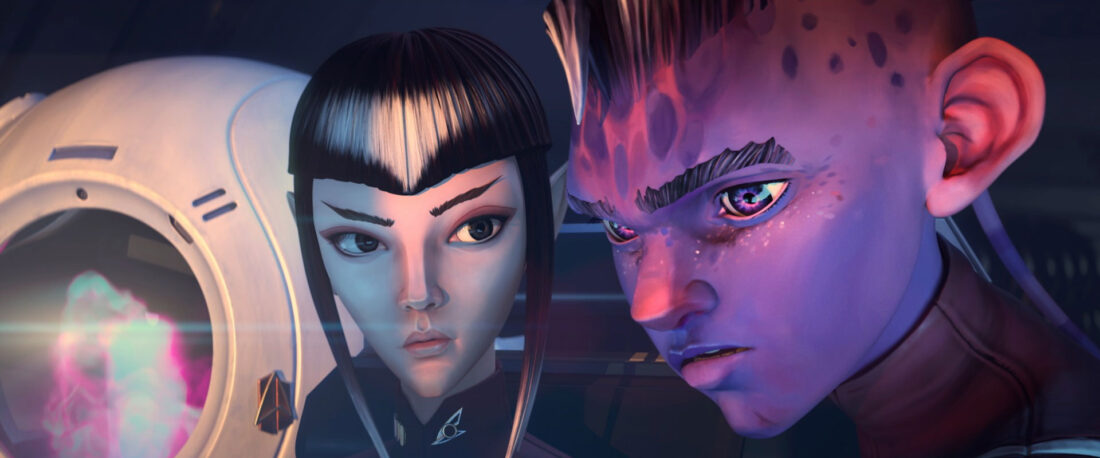
We find that out from someone who’s been giving hints to the kids as to what to do to save people: The Traveler Formerly Known As Wes Crusher! Wearing a big leather duster over the peach sweater he wore in TNG’s “Where No One Has Gone Before” (the episode that introduced the concept of the Travelers), Wes is hilariously scattered, with Wil Wheaton doing a superlative job of voicing the Traveler. (Eric Menyuk also makes a vocal cameo as the Traveler he played on TNG in “Where No One…” “Remember Me,” and “Journey’s End.”) We see that the Travelers continue to work to guide the universe, as established in Wes’ prior appearance, Picard’s “Farewell,” which retroactively established that the Travelers were the ones behind Gary Seven and his mission in the original series’ “Assignment: Earth.” (We even have a room in his headquarters that is a re-creation of Gary Seven’s New York apartment in that 1968 episode, complete with the Beta 5 computer.) However, Wes is going against the wishes of his fellow Travelers. They want to abandon this timeline to the Loom, as it’s broken, but Wes—ever the engineer—wants to fix it. To that end, he’s been guiding our heroes—he’s the one who sends them to Icila, the desert planet where Chakotay and Adreek crash-landed the Protostar. And he’s the one who guides them more overtly on the road to fixing the timeline.
Wes’ presence in this season is a joy. (It also adds Wheaton to the growing list of people who’ve played the same role in three or more different Trek TV shows.) He’s obviously operating on a different level of understanding, and it makes it hard for him to communicate properly to the “lower” beings. But he’s also determined to save this timeline. (“This universe is my home. My mom lives here! I’m not gonna let it die.”)
But Wes is also just a catalyst for the plot. The main characters are still the gang of kids who stole the Protostar last year, which sent them on an odyssey that resulted in their being warrant officers and Academy hopefuls. Every one of them has a wonderful journey to go on this season.
Dal gets several hard lessons in the realities of command, including the rather boring academic side of things. (A hilarious running gag through the early episodes is Dal constantly being asked, “Haven’t you read Temporal Mechanics 101?” He finally does read it, and in a delightful touch, it’s narrated by an animated version of the show’s science advisor, the magnificent Dr. Erin Macdonald.) He also realizes that there are times when he needs to step back and let other people take charge. Notably, at one point he’s recruited to replace a cadet who’s been injured (said cadet is a Lurian, and in an amusing touch, she never gets any dialogue) to pilot a support ship, where he works nicely as part of the team. And in the end, he defers to Gwyn as captain, accepting the role of first officer.
One of the people Dal learns from is Chakotay, and that goes both ways, as Dal helps remind Chakotay of what being a captain means. By the time our heroes find Chakotay, Adreek has died and Chakotay has been alone for a decade with only holo-Janeway for company. He’s mostly given up, especially since Protostar can’t take off. But the kids in general and Dal in particular enable him to get his groove back.
Gwyn starts out going to Solum in the hopes of preparing the ground for Federation contact in a way that won’t result in a civil war. Unfortunately, Asencia got there first, and has already poisoned the Vau N’akat against the Federation. Gwyn challenges her to a ritual that she can’t possibly refuse, because alien species always have a ritual challenge that you can’t possibly refuse, and Gwyn loses. She manages to escape Solum, thanks in part to her father—who is now just Ilthurian, a Vau N’akat astronomer, not yet the Diviner (with John Noble using his sweet-old-man voice instead of his evil snarly voice). Eventually, she is able to defeat Asencia thanks to help from her fellow Starfleet warrant officers, Voyager, Wes, and, best of all, her father and the younger version of Asencia, who is disgusted by her older self and does not want to age into that. And in the end, Gwyn—who has proven herself to be a much more able leader than Dal—winds up in charge.
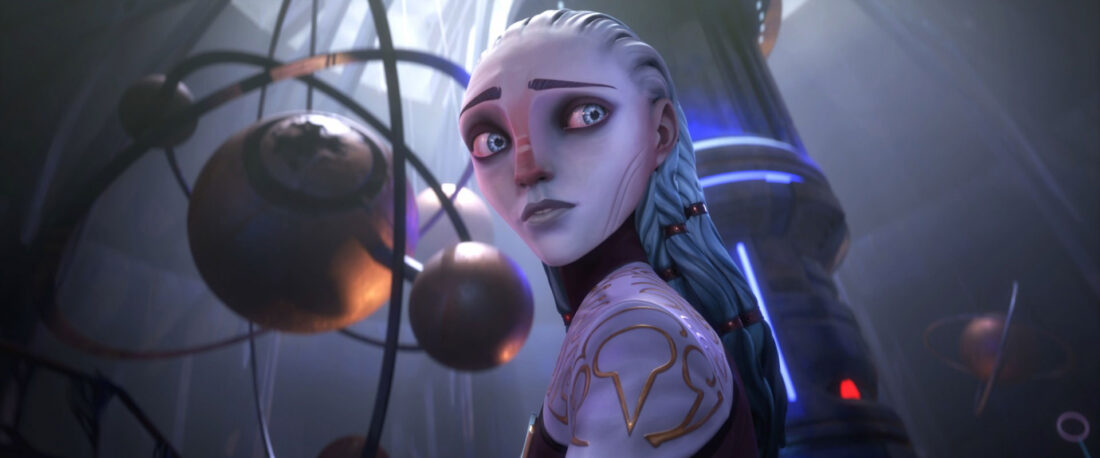
Rok has become the quintessential Starfleet officer, and she isn’t even a Starfleet officer yet! “I love science so much!” she says at one point, echoing Spock’s words in Discovery’s “Perpetual Infinity.” She’s the one able to come up with the brilliant solution to the problem, the source of many a great moment in Trek, from Spock and Scotty to Data and La Forge to Dax and O’Brien to Janeway and Torres to T’Pol and Tucker to pretty much the entire Discovery crew. One of the best bits in the season is when Rok is trying to figure out a way to reverse-engineer some genetically engineered tribbles that a Klingon scientist has accidentally turned into predators. Dal excitedly says, “I love this part! She gets that look when she’s close to a breakthrough!” which prompts Gwyn to say, “Shh! She’s hypothesizing!”
I particularly love that Rok is insistent on following the rules far more than her teammates. (Though one wonders if that was in part done to limit the amount of time the underaged Rylee Alazraqui has to work.) She doesn’t go with them to steal the Infinity, for one thing. And on top of that, when one of their crazy-ass plans go wrong, it’s Rok who’s able to come up with the solution because of her nature. The gang has created hologram duplicates of themselves so they can steal the Infinity (again) without anyone noticing that they’re gone. But the holograms are too good—they think they’re the real thing, and so they try to steal the Infinity and stop the “holograms” from getting in their way. All the gang work against their duplicates—except for the two Roks who, of course, work together in perfect harmony and come up with a solution together…
Zero has the most tragic journey to go on, as his suit is damaged beyond the ability of the crew to repair when they encounter a crazy AI (because it wouldn’t be Trek without a crazy AI, in this case one that takes over a Kazon maje and a Borg transwarp hub). But they come across a world filled with non-corporeal beings who have managed to acquire bodies for themselves. This gives us a classic Trekkish tale, as one of the themes of the franchise from the very beginning has been the dangers of letting one evolve so far past standard humanoid life that you lose the ability to feel and sense and take joy. (See in particular the Talosians in “The Cage,” whose telepathy allowed everything else about them to atrophy, or the way aliens in human form succumbed to the joy of sensation in “By Any Other Name” and “Catspaw,” or the actions of Sargon, Thalassa, and Henoch after they got bodies for the first time in forever in “Return to Tomorrow.”) Zero does get a body, which he loves, but there’s, as always, a catch: he can’t leave the planet. If he does, the body will break down. As indeed happens in fairly short order, to the point that Zero is back in a new suit by the end of the season. (Though he sacrifices his corporeal body to save everyone, as is fitting.) Jankom was able to build him a new suit, though, one that enables him to feel.
Speaking of Jankom, he’s the only one who doesn’t have much of a journey to go on. He starts out the season trying to be polite and generally behave in a manner befitting an officer, and also following engineering regulations. This goes very badly for him, and he soon realizes that being a loudmouth who uses percussive maintenance to get stuff done is really his brand, and he needs to embrace it. However, he continues to be the quintessential Starfleet engineer, albeit one who’s a bit rougher around the edges. Still, he’s worthy to be in the pantheon of miracle workers alongside Scotty, La Forge, O’Brien, Rom, Nog, Torres, Tucker, Reno, Billups, Rutherford, Hemmer, and Pelia.
Murf continues to be Murf. Murf is the best. That is all.
The storyline for the season flows beautifully. It works as a marathon watch, it works as individual episodes, and the storyline doesn’t feel padded or rushed at any point. In an era where so many shows try to find the sweet spot in the right number of episodes to do for a particular plot and failing, the Hageman Brothers and their team of writers have done a spectacular job of finding a storyline that actually fits perfectly in twenty half-hour installments.
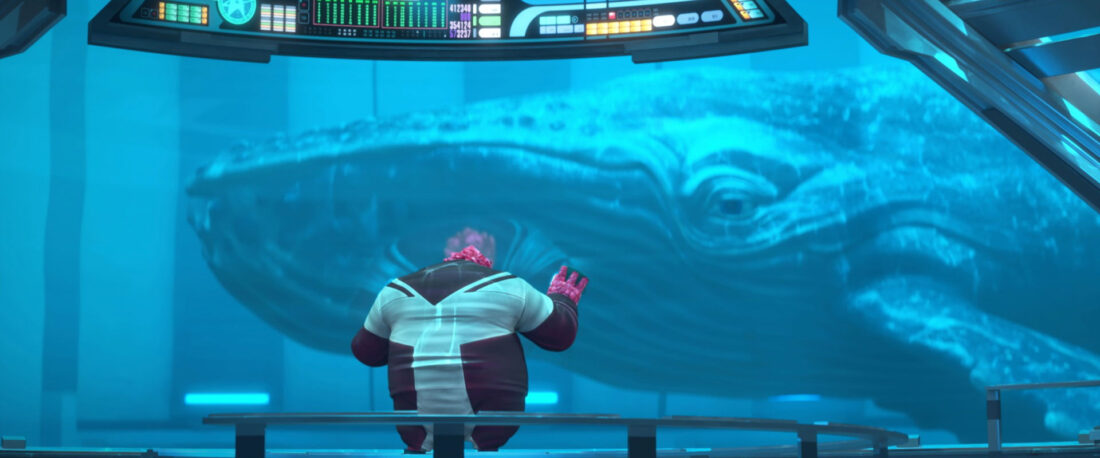
The show also embraces its place in the Trek universe seamlessly and without overdoing the fanwank. Sometimes it’s something small, like a time-twisting device created by Wes that references Boreth (home of time crystals, as seen in Discovery’s “Through the Valley of Shadows”) and the Bajoran Orb of Time (introduced in DS9’s “Trials and Tribble-ations”), or Maj’el referencing DS9’s “Past Tense” two-parter and First Contact as examples of time travelers becoming part of history, as it were, which is what the gang does this season. Besides Jellico returning, we also twice get Beverly Crusher, voiced by Gates McFadden, in an appearance that tracks nicely with her backstory established in Picard season three. (In a lovely moment, Wes visits his Mom for the first time in far too long, and Crusher introduces Wes to his infant half-brother, who will grow up to be Ed Speleers…) When taking on the Loom—who are giant floating insectoid creatures—Janeway is seen wearing the same tank top she wore the last time she took on giant floating creatures, in Voyager’s “Macrocosm.” Tysses at one point utters, “Great Uvazeh,” which is an Andorian deity created for the tie-in fiction, and which made my little heart proud.
And, best of all, the EMH at one point says of our heroes, “I haven’t seen a crew this dysfunctional since the Cerritos,” which I hope presages an appearance on LD by the good doctor. Plus, the EMH is still writing holonovels, and from the descriptions, they’re still pretty terrible…
We get plenty of Trek standbys besides those mentioned (evolved beings wanting senses, an insane AI, science-ing the crap out of a situation), including a redo of Voyager’s “Shattered,” in which Voyager has been subdivided into several different quantum realities. The solution is right out of TNG’s “Parallels,” and it even includes a visit to the Mirror Universe, as well as another appearance by the eyepatched Okona (whom the kids encountered last season, again voiced by Billy Campbell, reprising his role from TNG’s “The Outrageous Okona”). In an amusing touch, Mirror Janeway has a Borg implant over her left eye just like the one Seven of Nine has in the mainline universe.
And, just like LD, Prodigy takes advantage of being animated to provide us with Voyager’sCetacean Ops! And while Gillian the humpback whale navigator (obviously named after Gillian Taylor from The Voyage Home) isn’t quite as fabulous as Kimolu and Matt from LD, she’s still pretty amazing (and wonderfully voiced by the great Bonnie Gordon, who also voices the ship’s computer and various other roles). Plus, we even get to see Gillian’s evil Mirror Universe counterpart! (Prompting the plaintive cry from Jankom, “Even the whales are evil?”)
The best thing about this show is that it works at everything it attempts. As a Star Trek show, it’s magnificent, embodying the optimistic, compassionate future created by Gene Roddenberry and developed by so many over the past six decades. As an animated series, it takes full advantage, giving us some glorious aliens (the Loom, the Nazamon, the bodies created for non-corporeals) and some spectacular landscapes. As a kids’ show it never loses sight of the fact that these are young people trying to find their place in the galaxy, without ever once talking down to them.
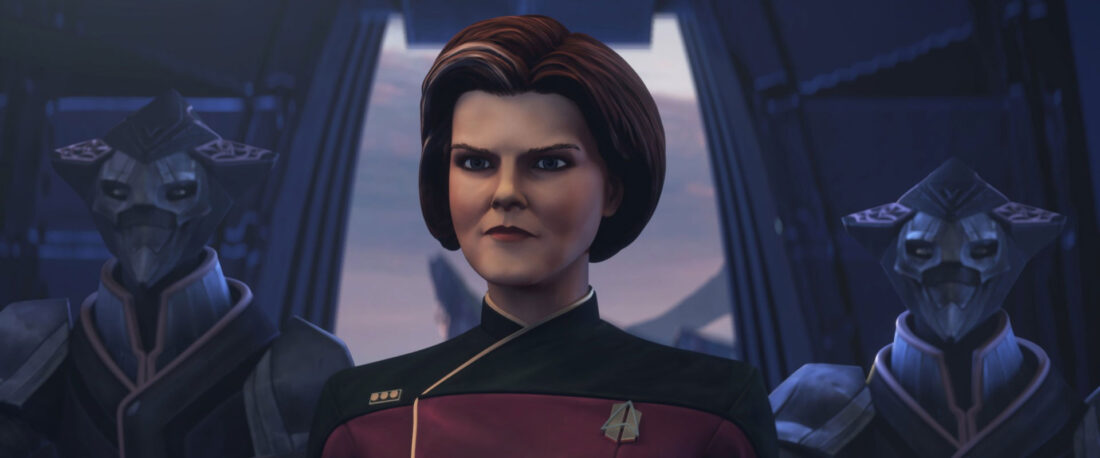
In the end, our heroes get into the Academy, and we see them taking classes and learning things (including attending Dr. Erin’s Temporal Mechanics 201…). But then the synth attack on Mars happens (as dramatized in the Short Trek “Children of Mars,” and the fallout of which was seen in various flashbacks in Picard season one). A new Protostar was built for exploration, but the fallout from the synth attack is that Starfleet is cutting back on exploration. Janeway—who had retired—comes out of retirement and convinces Jellico to not mothball the new Protostar, but instead have it be a combination training/exploration vessel. Dal, Gwyn, Rok, Zero, Jankom, Murf, and Maj’el are given field promotions to ensign and assigned to the new Protostar, and they’ll be assisted by an Emergency Command Hologram—yes, holo-Janeway’s back! And in the role that the EMH pioneered in Voyager’s “Tinker Tenor Doctor Spy.”
Our heroes then fly off in the Protostar—which they didn’t even have to steal this time!—and get ready to explore strange new worlds, and all that good stuff.
Let’s hope that we get the third season that this show absolutely deserves to see those adventures. It’s, frankly, despicable and revolting that we live in a world where it makes more financial sense for a production company to not produce a TV show and take a tax writeoff than it is to actually produce a damn TV show. It’s absurd that Prodigy isn’t on Paramount+ with the rest of the Trek stable, and good on Netflix for rescuing it from a capitalistic oblivion.
Prodigy is still the best of the new Trek shows.










